

This article's lead section may be too short to adequately summarize the key points. Please consider expanding the lead to provide an accessible overview of all important aspects of the article. (June 2023)
|
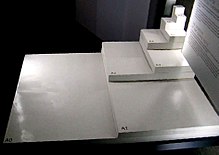
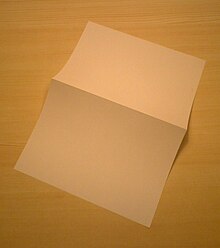
ISO 216 is an international standard for paper sizes, used around the world except in North America and parts of Latin America. The standard defines the "A", "B" and "C" series of paper sizes, which includes the A4, the most commonly available paper size worldwide. Two supplementary standards, ISO 217 and ISO 269, define related paper sizes; the ISO 269 "C" series is commonly listed alongside the A and B sizes.
All ISO 216, ISO 217 and ISO 269 paper sizes (except some envelopes) have the same aspect ratio, √2:1, within rounding to millimetres. This ratio has the unique property that when cut or folded in half widthways, the halves also have the same aspect ratio. Each ISO paper size is one half of the area of the next larger size in the same series.[1]
| Size | A series formats | B series formats | C series formats | ||||||
|---|---|---|---|---|---|---|---|---|---|
| name | mm | inches | name | mm | inches | name | mm | inches | |
| -2 | 4A0 | 1682 × 2378 | 66.2 × 93.6 | ||||||
| -1 | 2A0 | 1189 × 1682 | 46.8 × 66.2 | ||||||
| 0 | A0 | 0841 × 1189 | 33.1 × 46.8 | B0 | 1000 × 1414 | 39.4 × 55.7 | C0 | 0917 × 1297 | 36.1 × 51.1 |
| 1 | A1 | 0594 × 0841 | 23.4 × 33.1 | B1 | 0707 × 1000 | 27.8 × 39.4 | C1 | 0648 × 0917 | 25.5 × 36.1 |
| 2 | A2 | 0420 × 0594 | 16.5 × 23.4 | B2 | 0500 × 0707 | 19.7 × 27.8 | C2 | 0458 × 0648 | 18.0 × 25.5 |
| 3 | A3 | 0297 × 0420 | 11.7 × 16.5 | B3 | 0353 × 0500 | 13.9 × 19.7 | C3 | 0324 × 0458 | 12.8 × 18.0 |
| 4 | A4 | 0210 × 0297 | 08.3 × 11.7 | B4 | 0250 × 0353 | 09.8 × 13.9 | C4 | 0229 × 0324 | 09.0 × 12.8 |
| 5 | A5 | 0148 × 0210 | 05.8 × 08.3 | B5 | 0176 × 0250 | 06.9 × 09.8 | C5 | 0162 × 0229 | 06.4 × 09.0 |
| 6 | A6 | 0105 × 0148 | 04.1 × 05.8 | B6 | 0125 × 0176 | 04.9 × 06.9 | C6 | 0114 × 0162 | 04.5 × 06.4 |
| 7 | A7 | 0074 × 0105 | 02.9 × 04.1 | B7 | 0088 × 0125 | 03.5 × 04.9 | C7 | 0081 × 0114 | 03.2 × 04.5 |
| 8 | A8 | 0052 × 0074 | 02.0 × 02.9 | B8 | 0062 × 0088 | 02.4 × 03.5 | C8 | 0057 × 0081 | 02.2 × 03.2 |
| 9 | A9 | 0037 × 0052 | 01.5 × 02.0 | B9 | 0044 × 0062 | 01.7 × 02.4 | C9 | 0040 × 0057 | 01.6 × 02.2 |
| 10 | A10 | 0026 × 0037 | 01.0 × 01.5 | B10 | 0031 × 0044 | 01.2 × 01.7 | C10 | 0028 × 0040 | 01.1 × 01.6 |
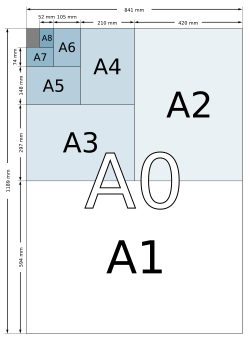
|

|
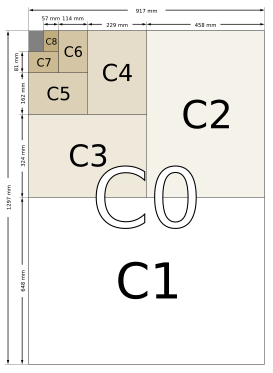
| |||||||
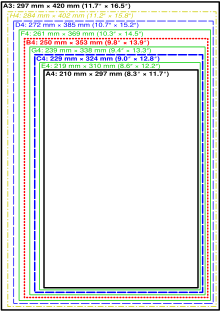
 , see Square root of 2.
, see Square root of 2.
The oldest known mention of the advantages of basing a paper size on an aspect ratioof

Searching for a standard system of paper formats on a scientific basis at the Bridge association (German: Die Brücke), as a replacement for the vast variety of other paper formats that had been used before, in order to make paper stocking and document reproduction cheaper and more efficient, in 1911 Wilhelm Ostwald proposed, over a hundred years after the 1798 French law,[3] a global standard – aworld format (Weltformat) – for paper sizes based on the ratio 




In 1921, after a long discussion and another intervention by Porstmann, the Standardisation Committee of German Industry (Normenausschuß der deutschen Industrie, or NADI in short), which is the German Institute for Standardisation (Deutsches Institut für Normung, or DIN in short) today, published German standard DI Norm 476 the specification of four series of paper formats with ratio 
The DIN paper-format concept was soon introduced as a national standard in many other countries, for example, Belgium (1924), Netherlands (1925), Norway (1926), Switzerland (1929), Sweden (1930), Soviet Union (1934), Hungary (1938), Italy (1939), Finland (1942), Uruguay (1942), Argentina (1943), Brazil (1943), Spain (1947), Austria (1948), Romania (1949), Japan (1951), Denmark (1953), Czechoslovakia (1953), Israel (1954), Portugal (1954), Yugoslavia (1956), India (1957), Poland (1957), United Kingdom (1959), Venezuela (1962), New Zealand (1963), Iceland (1964), Mexico (1965), South Africa (1966), France (1967), Peru (1967), Turkey (1967), Chile (1968), Greece (1970), Zimbabwe (1970), Singapore (1970), Bangladesh (1972), Thailand (1973), Barbados (1973), Australia (1974), Ecuador (1974), Colombia (1975) and Kuwait (1975).
It finally became both an international standard (ISO 216) as well as the official United Nations document format in 1975, and it is today used in almost all countries in the world, with the exception of several countries in the Americas.
In 1977, a large German car manufacturer performed a study of the paper formats found in their incoming mail and concluded that out of 148 examined countries, 88 already used the A series formats.[4]
The main advantage of this system is its scaling. Rectangular paper with an aspect ratio of 



The ISO system of paper sizes exploits these properties of the 
This system also simplifies calculating the weight of paper. Under ISO 536, paper's grammage is defined as a sheet's mass in grams (g) per area in square metres (unit symbol g/m2; the nonstandard abbreviation "gsm" is also used).[5] One can derive the grammage of other sizes by arithmetic division. A standard A4 sheet made from 80 g/m2 paper weighs 5 grams (0.18 oz), as it is 1⁄16 (four halvings, ignoring rounding) of an A0 page. Thus the weight, and the associated postage rate, can be approximated easily by counting the number of sheets used.
ISO 216 and its related standards were first published between 1975 and 1995:
Paper in the A series format has an aspect ratio of √2 (≈ 1.414, when rounded). A0 is defined so that it has an area of 1 m2 (11 sq ft) before rounding to the nearest 1 millimetre (0.039 in). Successive paper sizes in the series (A1, A2, A3, etc.) are defined by halving the area of the preceding paper size and rounding down, so that the long side of A(n + 1) is the same length as the short side of An. Hence, each next size is nearly exactly half the area of the prior size. So, an A1 page can fit two A2 pages inside the same area.
The most used of this series is the size A4, which is 210 mm × 297 mm (8.27 in × 11.7 in) and thus almost exactly 1⁄16 square metre (0.0625 m2; 96.8752 sq in) in area. For comparison, the letter paper size commonly used in North America (8+1⁄2 in × 11 in; 216 mm × 279 mm) is about 6 mm (0.24 in) wider and 18 mm (0.71 in) shorter than A4. Then, the size of A5 paper is half of A4, i.e. 148 mm × 210 mm (5.8 in × 8.3 in).[6][7]
The geometric rationale for using the square root of 2 is to maintain the aspect ratio of each subsequent rectangle after cutting or folding an A-series sheet in half, perpendicular to the larger side. Given a rectangle with a longer side, x, and a shorter side, y, ensuring that its aspect ratio, x/y, will be the same as that of a rectangle half its size, y/x/2, which means that x/y = y/x/2, which reduces to x/y = √2; in other words, an aspect ratio of 1:√2.
Any An paper can be defined as An = S × L, where (measuring in metres)

Therefore
 ,
, 
 Etc.
Etc.The B series is defined in the standard as follows: "A subsidiary series of sizes is obtained by placing the geometrical means between adjacent sizes of the A series in sequence." The use of the geometric mean makes each step in size: B0, A0, B1, A1, B2 ... smaller than the previous one by the same factor. As with the A series, the lengths of the B series have the ratio √2, and folding one in half (and rounding down to the nearest millimetre) gives the next in the series. The shorter side of B0 is exactly 1 metre.
There is also an incompatible Japanese B series which the JIS defines to have 1.5 times the area of the corresponding JIS A series (which is identical to the ISO A series).[8] Thus, the lengths of JIS B series paper are √1.5 ≈ 1.22 times those of A-series paper. By comparison, the lengths of ISO B series paper are 4√2 ≈ 1.19 times those of A-series paper.
Any Bn paper (according to the ISO standard) can be defined as Bn = S × L, where (measuring in metres)

Therefore
 ,
, 
 Etc.
Etc.The C series formats are geometric means between the B series and A series formats with the same number (e.g. C2 is the geometric mean between B2 and A2). The width to height ratio of C series formats is √2 as in the A and B series. A, B, and C series of paper fit together as part of a geometric progression, with ratio of successive side lengths of 8√2, though there is no size half-way between Bn and A(n − 1): A4, C4, B4, "D4", A3, ...; there is such a D-series in the Swedish extensions to the system. The lengths of ISO C series paper are therefore 8√2 ≈ 1.09 times those of A-series paper.
The C series formats are used mainly for envelopes. An unfolded A4 page will fit into a C4 envelope. Due to same width to height ratio, if an A4 page is folded in half so that it is A5 in size, it will fit into a C5 envelope (which will be the same size as a C4 envelope folded in half).
Any Cn paper can be defined as Cn = S × L, where (measuring in metres)

Therefore
 ,
, 
 Etc.
Etc.The tolerances specified in the standard are:
These are related to comparison between series A, B and C.
The ISO 216 formats are organized around the ratio 1:√2; two sheets next to each other together have the same ratio, sideways. In scaled photocopying, for example, two A4 sheets reduced to A5 size fit exactly onto one A4 sheet, and an A4 sheet in magnified size onto an A3 sheet; in each case, there is neither waste nor want.
The principal countries not generally using the ISO paper sizes are the United States and Canada, which use North American paper sizes. Although they have also officially adopted the ISO 216 paper format, Mexico, Panama, Peru, Colombia, the Philippines, and Chile also use mostly U.S. paper sizes.
Rectangular sheets of paper with the ratio 1:√2 are popular in paper folding, such as origami, where they are sometimes called "A4 rectangles" or "silver rectangles".[9] In other contexts, the term "silver rectangle" can also refer to a rectangle in the proportion 1:(1 + √2), known as the silver ratio.
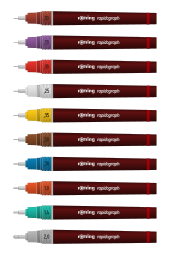
An adjunct to the ISO paper sizes, particularly the A series, are the technical drawing line widths specified in ISO 128. For example, line type A ("Continuous - thick", used for "visible outlines") has a standard thickness of 0.7 mm on an A0-sized sheet, 0.5 mm on an A1 sheet, and 0.35 mm on A2, A3, or A4.[10]
The matching technical pen widths are 0.13, 0.18, 0.25, 0.35, 0.5, 0.7, 1.0, 1.40, and 2.0 mm, as specified in ISO 9175-1. Colour codes are assigned to each size to facilitate easy recognition by the drafter. Like the paper sizes, these pen widths increase by a factor of √2, so that particular pens can be used on particular sizes of paper, and then the next smaller or larger size can be used to continue the drawing after it has been reduced or enlarged, respectively.[4][11]
| Linewidth (mm) | 0.10 | 0.13 | 0.18 | 0.25 | 0.35 | 0.50 | 0.70 | 1.0 | 1.4 | 2.0 | ||||||||||
|---|---|---|---|---|---|---|---|---|---|---|---|---|---|---|---|---|---|---|---|---|
| Colour | Maroon | Violet | Red | White | Yellow | Brown | Blue | Orange | Green | Gray | ||||||||||

The earlier DIN 6775 standard upon which ISO 9175-1 is based also specified a term and symbol for easy identification of pens and drawing templates compatible with the standard, called Micronorm, which may still be found on some technical drafting equipment.
DIN 476 provides for formats larger than A0, denoted by a prefix factor. In particular, it lists the formats 2A0 and 4A0, which are twice and four times the size of A0 respectively:
| Name | mm × mm | inch × inch |
|---|---|---|
| 4A0 | 1682 × 2378 | 66+5⁄24 × 93+5⁄8 |
| 2A0 | 1189 × 1682 | 46+19⁄24 × 66+5⁄24 |
While not formally defined, ISO 216:2007 notes them in the table of Main series of trimmed sizes (ISO A series) as well: "The rarely used sizes [2A0 and 4A0] which follow also belong to this series." 2A0 is also known by other unofficial names like "A00".[12]
|
| |
|---|---|
| DIN standards |
|
| Committees |
|
| Connectors |
|
| Rails |
|